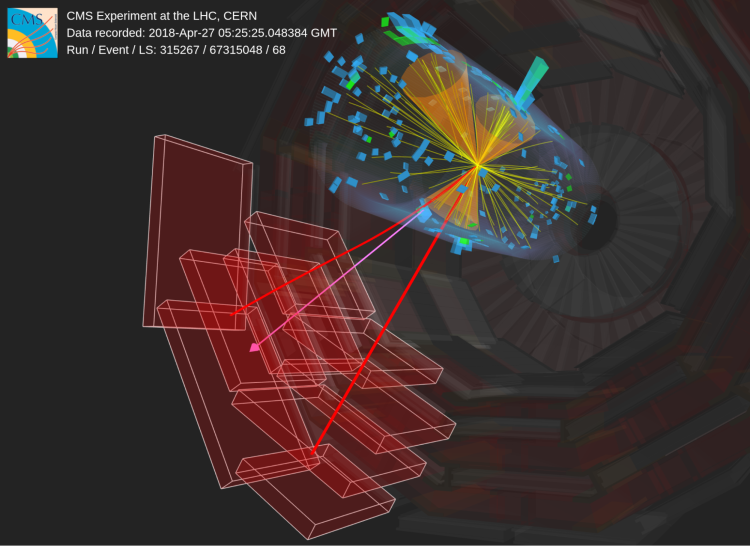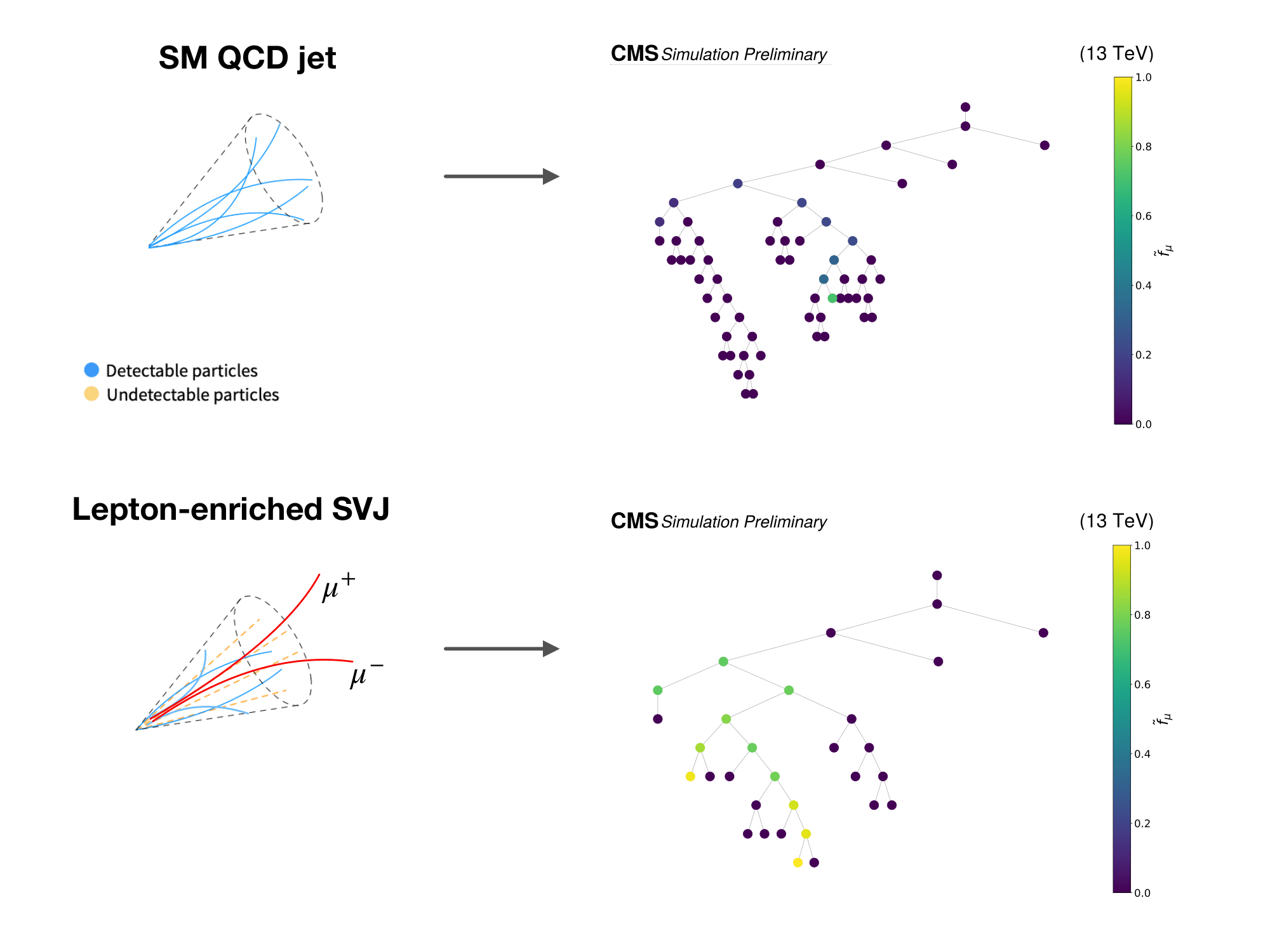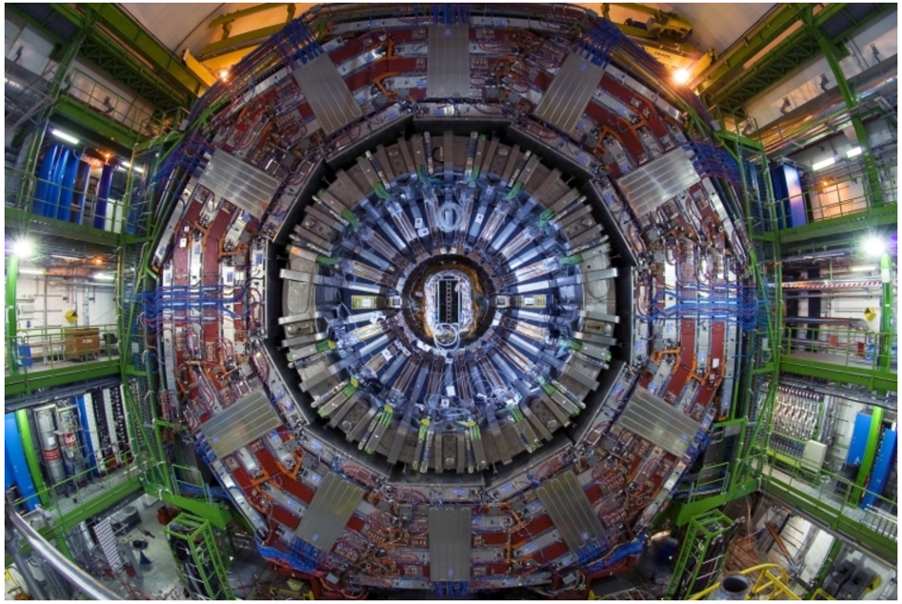
In the first search of its kind at a particle collider, the CMS experiment looks for partially visible sprays of particles (jets), containing leptons and dark matter using physics-informed machine learning.
Can we shed light on dark matter?
Our universe may conceal far more than what we can see. Physicists have long theorized about the existence of a dark sector — an undiscovered set of particles and forces beyond the well-tested laws of known physics, described by the Standard Model (SM), and possibly connected with the existence of dark matter. But how do you search for something so elusive?
Scientists at the CMS experiment at CERN’s Large Hadron Collider (LHC) have taken an important step towards uncovering the secrets of the dark sector. For the first time, they have searched for the formation of collimated sprays of particles (jets) that are partly invisible (dark) and partly visible, which originate from dark-sector particles decaying into a mix of ordinary quarks and leptons (such as electrons or muons). These sprays are called semi-visible jets with leptons, denoted by SVJℓ. This unusual signature could arise if dark sector particles are bound together by a force resembling the strong interaction that ties quarks inside protons and neutrons. This hypothetical counterpart is known as the dark strong force.
Machine learning meets physics
To uncover these rare signals, the CMS team turned to an innovative machine learning approach based on LundNet, a graph neural network that analyzes jets by tracing their formation history. Unlike standard approaches that treat jets simply as collections of particles, LundNet builds a physics-inspired Lund jet graph that maps how the jet develops in both the Standard Model of the known particles and forces and potential dark-sector scenarios.
The figure below illustrates how this graph tracks the energy of a given particle type, such as a muon, evolve during the jet formation, and this provides a crucial handle to separate SVJℓ from SM jets. Lund graphs capture the subtle differences between the internal structure of jets originating from dark sectors and that of ordinary SM jets.
Identifying the rare signals, however, is only half the challenge. A significant hurdle is the overwhelming background: the multitude of the known collisions that can mimic new physics. To tackle this, the team devised an innovative method that uses machine learning to identify potential signals and also to learn how the background behaves directly from the data. The powerful combination of physics-informed machine learning and this data-driven background estimation sharpens the search, boosting the chances of spotting signs of new physics hidden in the LHC data.

Top: example of Lund graph for a SM jet, bottom: example of Lund graph for a SVJℓ. The color gradient in the Lund graphs on the right represents the evolution of the energy carried by muons in the jet formation history.
The results and why they matter
Using the full CMS Run 2 dataset (2016–2018), the team found no apparent signs of dark sector particles. However, they set the first-ever exclusion limits on models that predict SVJℓ, and exclude Z′ boson masses up to 4.7 TeV, depending on the details of the model.
This achievement:
- opens a new frontier in dark sector searches by exploring a previously overlooked signature.
- demonstrates how physics-informed machine learning can uncover hidden patterns in complex data.
- complements existing searches that focus on jets containing only hadrons or missing energy signatures.
Cesare Tiziano Cazzaniga from the analysis team explains, “The Lund graph lets us probe the jet’s internal history, allowing us to reconstruct footprints left by particles belonging to a hidden world. It’s a powerful way to listen for these subtle signals at colliders.”
Dr. Roberto Seidita, also part of the analysis team, adds, “Modern machine learning allows us to not only exploit the full richness of what CMS can record, but also to learn challenging backgrounds directly from the data itself”.
Prof. Dr. Annapaola de Cosa, who played a leading role in the analysis team, stresses the importance of venturing into unexplored territory in the hunt for new physics. “We want to leave no stone unturned. That means looking at every unconventional signature we can think of and squeezing the most out of the LHC data”, she says.
What’s next?
The techniques developed here pave the way for future searches at the LHC and beyond, where increasingly sophisticated machine learning models will listen for new physics hiding in complex final states. This research demonstrates the exciting potential of combining physics insight with cutting-edge machine learning to explore the unknown.
Written by: Cesare Tiziano Cazzaniga, for the CMS Collaboration
Edited by: Muhammad Ansar Iqbal
Read more about these results:
-
CMS Physics Analysis Summary (EXO-24-029): "Search for s-channel production of lepton-enriched semivisible jets in proton-proton collisions at 13 TeV"
-
@CMSExperiment on social media: Bluesky - Facebook - Instagram - LinkedIn - TikTok - Twitter/X - YouTube

